111 Search Results for rating scale
December 15, 2012
by Carole Zangari -
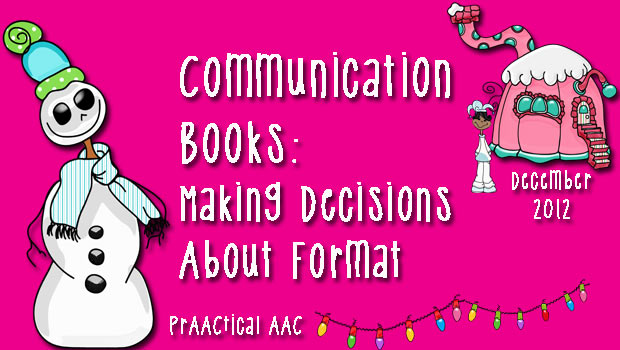
Four-year-old Josiah had a tiny one that was clipped to his belt loop so it was handy all throughout his day in preschool. Mr. Allan, who was hemiplegic and used a manual wheelchair, liked to keep one underneath his right thigh so he could grab it quickly whenever he wanted to talk. Dougie’s was big, really big, and he carried it under his arm wherever he went. Marla’s was a permanent fixture on her wheelchair laptray, and if she came without it because a caregiver forgot to put it on, it was likely to be a very l-o-n-g day. Geena’s looked like a DayPlanner and had it’s own special compartment in her purse. What are we talking about? Communication books, of course. And despite the fact that they all served the same general purpose, the communication books referenced in these examples couldn’t have looked more distinct. In this week’s post,... [Read More...]
December 5, 2012
by Robin Parker -
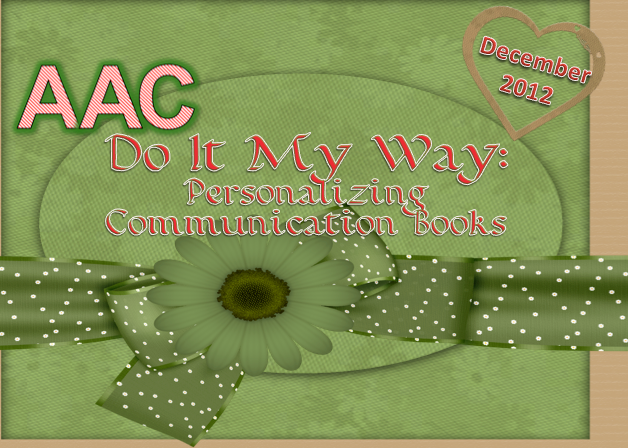
The topic of communication books was introduced this month. We will continue to think about the multitude of decisions to make as we design individual communication books. Obviously, content is the most important issue, but we are often reminded that function and form must go together. Carole gave some great examples of reasons to make the books appealing and personal. I had a situation this week that illustrated this concept perfectly. We continue to learn from the ‘learners’ that we are teaching. I know a little girl with autism who most people think does not care about her peers or how things look. She uses some natural speech and a no-tech communication book. She uses the communication book during her speech-language therapy sessions but only inconsistently outside of the therapy room. She has not expressed interest in taking the communication book with her and although she has some specific visual... [Read More...]
November 24, 2012
by Robin Parker -
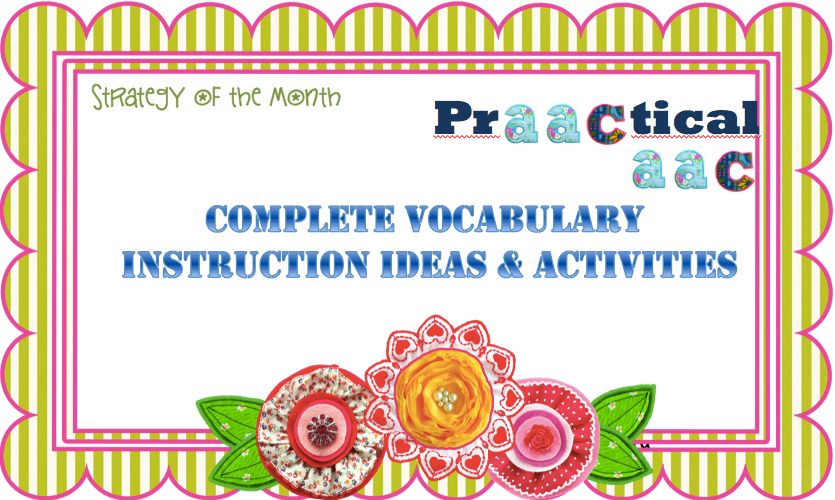
We love incorporating new vocabulary into fun motivating activities even when we are doing direct vocabulary instruction. We embed new vocabulary in activities using all of the language modalities- reading, writing, talking, and listening. We use planned vocabulary instruction activities as well as unexpected opportunities to embed new vocabulary. We like to stay within the theme of vocabulary learning but try and stay flexible in case a perfect opportunity arises that allows us to reflect back on an old vocabulary theme or mention a future planned theme. The main goal of direct vocabulary instruction is more than learning a new list of words, it is learning robust word knowledge so that language skills can be broadened. Consider these vocabulary instruction steps by Robert Marzano. These steps were not specifically developed for AAC users but if we add a language focus and a little more fun and active participation, they... [Read More...]
November 20, 2012
by Carole Zangari -
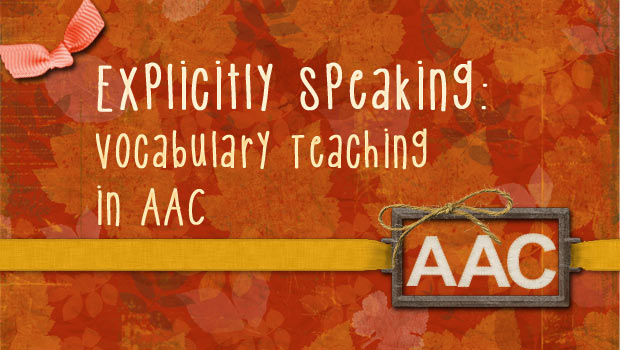
An essential part of the model we shared for AAC semantic intervention is Step 2, teaching the new words with explicit instruction activities. In our posts, explicit instruction refers to the process of designing and using carefully planned sequence of empirically-supported teaching activities. Though focused on reading, not vocabulary, development, this PowerPoint presentation by Dr. Anita Archer gives an excellent overview of the characteristics of explicit instruction. In our initial teaching of new words, we to be sure that the learners have frequent opportunities to respond: Active participation is critical at this point. We have to give the learner a lot of opportunities to say the word (e.g.,“resume”) and tell about it (e.g., “keep going,” “start again and not stop,” “verb”, etc.). We want to elicit a lot of responses so that we can monitor their performance. That allows us to provide feedback that is affirmative when the learners respond... [Read More...]
November 17, 2012
by Carole Zangari -
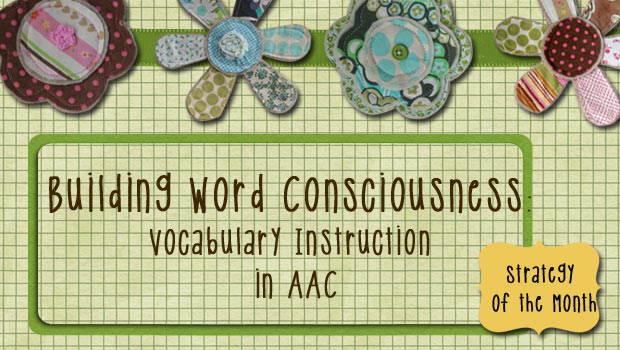
The mind is not a vessel to be filled but a fire to be kindled. Plutarch Last week, Robin discussed some strategies and activities for teaching new words to individuals who are at the earlier stages of language learning. This week, we move ahead and address semantic instruction for individuals who regularly create sentences to express themselves. One of my favorite things about working with AAC learners at this level is the opportunity for having metalinguistic conversations. Getting them to think and talk about language can accelerate their learning. Here are some prAACtical thoughts on how this relates to semantics with a focus on building word consciousness. We’re all familiar with music appreciation and art appreciation. I always think of word consciousness as a sort of like word appreciation. It refers to an awareness that words are the building blocks of language and that they can be examined and manipulated... [Read More...]
August 27, 2012
by Carole Zangari -

“How was school?” (Good) “What did you do?” (Nothing) This scenario plays out in many cars and kitchens in the after school hours and it can be hard to know who is more frustrated: the kids for being asked or the parents for not getting satisfactory answers. And still, we repeat the process day after day. Of course, we want to know the fine details of what happened and how our children felt, but in some cases, we’d settle for ANY school-related conversation at all. I’ll be the first to admit that it took me way too long to get the hang of how to get information about my children’s school days, and it seemed like just when I did, pow! They were pre-teens and then teenagers. New rule book. Here are some ‘lessons learned’ along the way about those afterschool conversations and some suggestions for parents of the kids... [Read More...]
August 22, 2012
by Carole Zangari -

We tried to be patient. We really did. We tried to wait until we had the new venue for our site all figured out and ready to go, but the truth is, we missed blogging and hated the thought of going a few more weeks without being able to post. So we decided to reactivate our old site for the time being and post occasionally to this site. Pardon our dorky look, please. In case you missed these on Facebook, here are are a couple of things we shared in the past few weeks: Lemonade: http://screencast.com/t/xaFcbxySW Building Classroom Participation: http://www.screencast.com/users/CZee/folders/Jing/media/15818f72-c49f-4da6-a12d-e52250794234 PrAACtical Alert: Online Trainings: http://bit.ly/NZ9HYT COCOA: http://www.edutecher.net/educlipper/index.php?shareImgid=2478 AAC Rating Scales: http://www.edutecher.net/educlipper/index.php?shareImgid=2499 and http://bit.ly/Ocgte5 And now onto something new… Last week, I had the chance to talk with Karyn, a mom whose adorable daughter with significant vision impairment and multiple disabilities is entering school for the first time. As she helped... [Read More...]
August 1, 2012
by Carole Zangari -
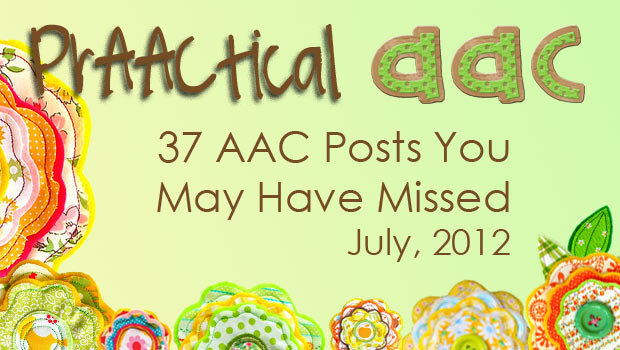
Biennial Conference: ISAAC 2012 PrAACtically There: ISAAC 2012 Day 1 at ISAAC 2012: What You Should Know About AAC’s Expanding Role in Health Care ISAAC 2012, Day 2: AAC Goes to Preschool ISAAC 2012, Day 3: Let the Games Begin ISAAC 2012, Day 4 – The Fives 5+5 Commandments for Speech Output Communication 5 Under-Used Strategies in AAC 5 Online Notebooks Full of AAC 5 Adapted Play Resources for Children with Motor Impairment – PrAACtical Thinking 92 Free or Lite Versions of AAC Apps PrAACtical Alert: Free AAC Evaluation App This Week Visualize 9 Nice Things to Say to Students who AAC PrAACtical Thoughts About Challenging Behavior PrAACtical Resource: Searching for AAC Devices with SpeechBubble AAC Assessment Round-Up 5 Ways to Use Rating Scales to Enhance Communication with AAC PrAACtical Alert: The World’s AAC Conference Comes to You (Well, a little bit of it) Power of the Visual Planner: 20... [Read More...]
July 14, 2012
by Carole Zangari -
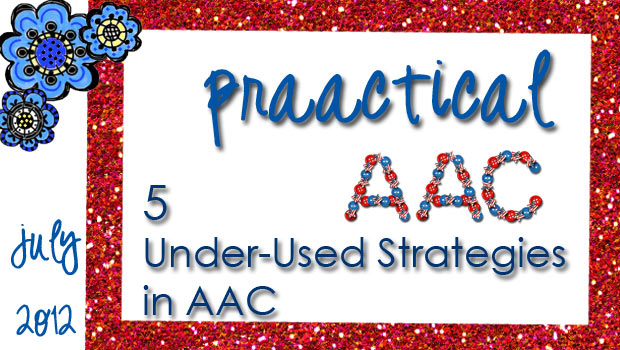
1. Partner-assisted scanning (PAS) offers great flexibility and spontaneity. Don’t want to take your SGD to the beach? A print-out of the screens and PAS is a great option. Missing key messages for the trip to the doctor’s office? A minute of brainstorming and the use of PAS may just save the day. No way for your client to access her device once she’s in bed? A communication board/book and PAS just might do the trick. – 2. Voice banking: For people are likely to lose their speech due to a degenerative disease, like ALS, the option of saving samples of their speech and having it digitized for future use seems to hold great appeal. We’d love to see more SLPs familiarize themselves with this strategy and the tools to implement it, so that this option is more widely used about individuals whose speech is deteriorating. – 3. Qualitative rating... [Read More...]
May 24, 2012
by Robin Parker -
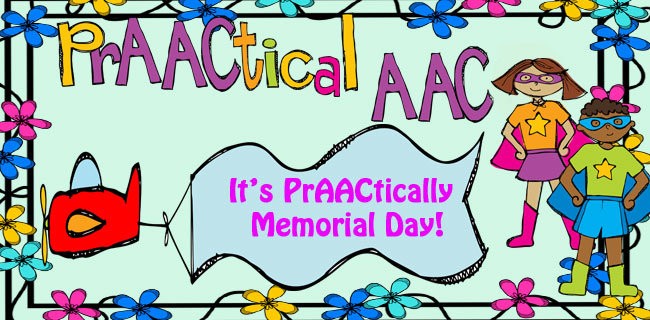
Memorial Day Weekend is big for us. We remember, appreciate, and honor the people who have protected our freedoms. We both have annual relaxing weekends planned. As we started to get ready, though, we started looking for Memorial Day AAC materials. It was surprising to see that there was not much to be found. We found some gluten-casein free Memorial Day recipes, which are great, but what about symbols to go with the recipes or symbols to explain the holiday and what about AAC language activities for the typical long weekend or trip? Not much…. So as we began preparing for our own weekends, these are some of the things we have done or are doing for PrAACtical AAC at home and on our mini-vacations: – Before We Leave Create a personal participation story (modified social story) so ALL the children can SEE the language for the trip. Here’s something that... [Read More...]









